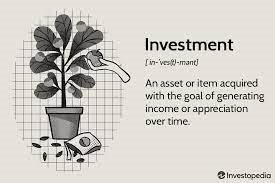
What is Investing? Investing is using your money to potentially create more money over a period of time.
Investing is different from saving: saving is putting money away in a low risk, fixed interest account as a cushion for emergencies or unexpected spending needs.
Is investing risky? It can be, but not investing can keep you from achieving your long-term goals. For one thing, the value of your savings will be eroded due to inflation. There are no low-risk savings vehicles paying 7% these days. Price increases are outpacing interest rates.
Investing in the stock market will grow your savings so that you can afford the things you’re saving for as well as pay the expenditures you can’t avoid, like taxes. Investing is a way to take care of your future self.
Here are a few facts about investing that will help you to invest with confidence.
The number one myth about investing is that markets always rise. This has not proven true in the last year. However, the market does tend to move in a positive trajectory. The S&P 500 has grown by an average of 12% per year for the past 10 years. In between the downturns, the overall pattern is growth.
Stocks sell at a multiple of earnings (price/earnings ratio). Rising stock prices depend on continuous earnings growth. If earnings decrease, stock prices decline. Companies are reporting slower earnings growth this year. Earnings matter. We learned this when the dot.com bubble burst in the early 2000s. Investors want their investment returned plus a profit in proportion to the risk taken.
In addition to companies’ earnings and economic data, the markets fluctuate based on consumer and investor confidence, and global political uncertainty.
People assume that financial experts make money by timing the markets. They move their money in and out when they expect it to rise or fall. This is nearly impossible to do without having a window into next week.
The smart investor knows that investing is not a beat-the-market game to get rich. The smart investor knows that past performance is not an indicator of future performance. The smart investor allocates their savings in a way that will help them to achieve their long-term financial goals.
The best way to invest is to invest regularly and to keep long-term returns in mind. Regular and consistent investing, for example contributing to your 401k every paycheck, will allow you to even out the frequent market fluctuations.
Another easy way to invest consistently is to have your dividends reinvested. Reinvesting dividends increases your total return over the long run; those small increments will add up over time. For more on this topic, please read on our website: https://www.regardingyourmoney.com/Dividends-for-Income-and-Total-Returns.c9947.htm
Keeping your eye on the long-term will help you to keep steady when there are market downturns. If your plan is to sell your stocks and keep the money in a risk-free savings account while you wait for the signal that the markets have bottomed out, you will most likely miss out on the growth from the eventual upturn.
Anyway, not all money in a savings account is without risk. With a US bank, you are protected up to $250,000 per depositor, per bank. But what if your bank turns out to be offshore? Or, what if your bank is in reality a crypto exchange? If the returns seem too good to be true, they probably are.
Additionally, not all government debt is equally safe. A US Treasury Bond held to maturity will return the original principal amount. However, not all governments treat their sovereign debt (bonds issued by a country’s government) with the same respect. Or, to put it another way, not all governments are solvent. If the returns seem too good to be true, they probably are.
So, now that we know investing and even saving is not without risk, how do we get the best returns for the least risk? After consistently putting money into investments, the most important strategy is to create a diversified portfolio. Diversifying your portfolio will lower your risk in the event one company, industry or asset class experiences a downturn. A well diversified portfolio holds various asset classes like stocks, bonds and alternative investments. This balances the risk and the returns in your portfolio and will drive your long-term investment performance.
You don’t have to make a big time commitment or become a financial markets expert to do this. Work with a Financial Advisor who has first hand knowledge of the markets’ many moving parts. A good financial advisor will keep you from making bad short term investment decisions during periods of extreme market volatility like the present.
Investing is not easy. Deciding what to invest in, for how long and how much to withdraw yearly calls for professional advice.
Please feel free to call (215-836-4880) or email the office
(ellend@regardingyourmoney.com) to set up an appointment to discuss any investment questions you may have.
Or, visit us at regardingyourmoney.com.
Sources: Moneyunder30.com, StandardChartered.com, Westernsouthern.com, Rbcgam.com, Bryce Sanders
